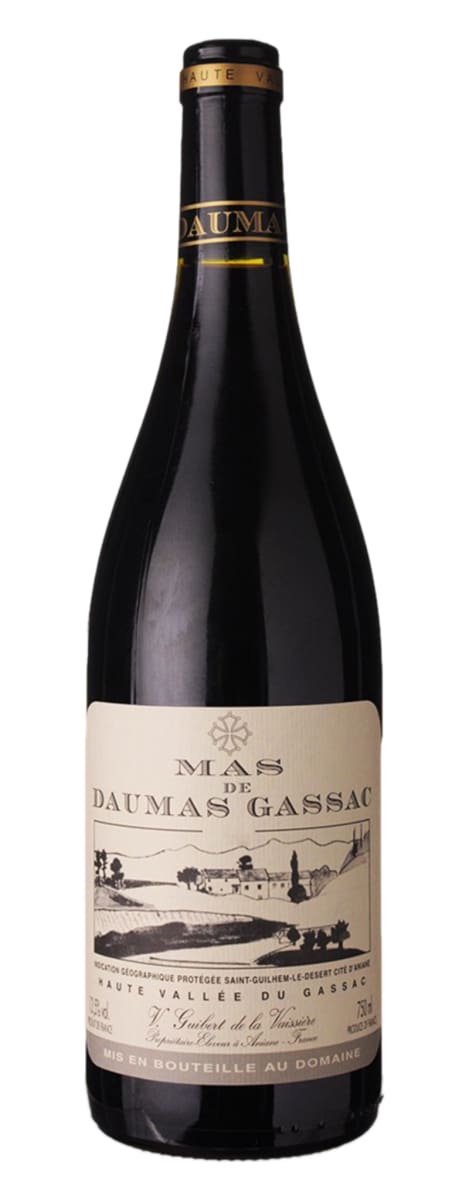Mas de Daumas Gassac Rouge 2021
-
James
Suckling



Product Details
Your Rating
Somm Note
Winemaker Notes
Perfect with complex dishes, red meat, game (especially venison and wild-boar) and cheeses.
Professional Ratings
-
James Suckling
Dark berries, leather, pencil lead, roasted meat, dried herbs, bell peppers, cumin, bay leaves and some stones. It’s medium-bodied with fine tannins and crisp acidity yet it has more intensity to deliver on the mid-palate. It’s poised with a restrained power. Harmonious and agile with great balance and vitality. Long, crunchy and developing finish. 84% cabernet sauvignon, 5% pinot noir, 2% merlot, 2% petit verdot, 2% cabernet franc, 2% tannat and 3% rare varieties. Try after 2026.
Other Vintages
2020-
Robert
Parker
-
James
Suckling - Decanter
-
James
Suckling
-
Robert
Parker -
James
Suckling


• soil so deep that the vine roots are forced to seek nourishment at great depth,
• soil so perfectly drained that it retains almost no humidity even after the most violent rainfall,
• soil so poor that the vine suffers to the very limits of endurance, thus creating unique aromas of exceptional originality.
At Daumas Gassac, every effort is made to protect the wild and natural beauty of the Gassac Valley and to preserve the "garrigue," the dominating feature of the landscape. The choice was made to create vineyards in small parcels or little clearings, engulfed by the extensive surrounding "garrigue". The wines at Daumas Gassac are, thus, enriched by the innumerable scents of Mediterranean shrubs packed tightly round the clearings. This practice which develops the individuality of the "terroir" is in complete contrast to modern viticultural techniques which tend towards vast areas of production with no other vegetation except for vines.
All our plants come from very old non-cloned vines. With our 6,000 plants per hectare we have 6,000 original plants instead of one single clone. Low yields, but prodigious richness and ability to stimulate all the senses. The introduction of clones is responsible for a dramatic decline in individuality to the advantage of standardization and high yields.

With hundreds of red grape varieties to choose from, winemakers have the freedom to create a virtually endless assortment of blended red wines. In many European regions, strict laws are in place determining the set of varieties that may be used, but in the New World, experimentation is permitted and encouraged resulting in a wide variety of red wine styles. Blending can be utilized to enhance balance or create complexity, lending different layers of flavors and aromas. For example, a red wine blend variety that creates a fruity and full-bodied wine would do well combined with one that is naturally high in acidity and tannins. Sometimes small amounts of a particular variety are added to boost color or aromatics. Blending can take place before or after fermentation, with the latter, more popular option giving more control to the winemaker over the final qualities of the wine.
How to Serve Red Wine
A common piece of advice is to serve red wine at “room temperature,” but this suggestion is imprecise. After all, room temperature in January is likely to be quite different than in August, even considering the possible effect of central heating and air conditioning systems. The proper temperature to aim for is 55° F to 60° F for lighter-bodied reds and 60° F to 65° F for fuller-bodied wines.
How Long Does Red Wine Last?
Once opened and re-corked, a bottle stored in a cool, dark environment (like your fridge) will stay fresh and nicely drinkable for a day or two. There are products available that can extend that period by a couple of days. As for unopened bottles, optimal storage means keeping them on their sides in a moderately humid environment at about 57° F. Red wines stored in this manner will stay good – and possibly improve – for anywhere from one year to multiple decades. Assessing how long to hold on to a bottle is a complicated science. If you are planning long-term storage of your reds, seek the advice of a wine professional.

An extensive appellation producing a diverse selection of good quality and great values, Languedoc spans the Mediterranean coast from the Pyrenees mountains of Roussillon all the way to the Rhône Valley. Languedoc’s terrain is generally flat coastal plains, with a warm Mediterranean climate and frequent risk of drought.
Virtually every style of wine is made in this expansive region. Most dry wines are blends with varietal choice strongly influenced by the neighboring Rhône Valley. For reds and rosés, the primary grapes include Grenache, Syrah, Carignan, Cinsault and Mourvèdre. White varieties include Grenache Blanc, Muscat, Ugni Blanc, Vermentino, Macabéo, Clairette, Piquepoul and Bourbelenc.
International varieties are also planted in large numbers here, in particular Chardonnay, Sauvignon Blanc and Cabernet Sauvignon.
The key region for sparkling wines here is Limoux, where Blanquette de Limoux is believed to have been the first sparkling wine made in France, even before Champagne. Crémant de Limoux is produced in a more modern style.
